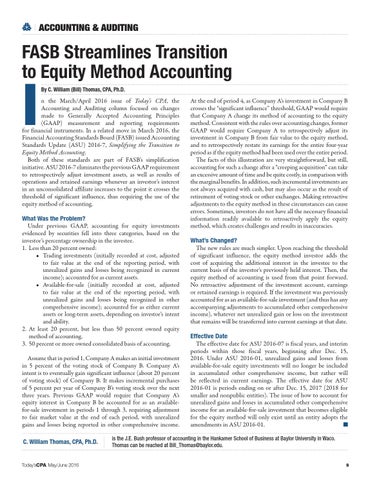ACCOUNTING & AUDITING
FASB Streamlines Transition to Equity Method Accounting
I
By C. William (Bill) Thomas, CPA, Ph.D.
n the March/April 2016 issue of Today’s CPA, the Accounting and Auditing column focused on changes made to Generally Accepted Accounting Principles (GAAP) measurement and reporting requirements for financial instruments. In a related move in March 2016, the Financial Accounting Standards Board (FASB) issued Accounting Standards Update (ASU) 2016-7, Simplifying the Transition to Equity Method Accounting. Both of these standards are part of FASB’s simplification initiative. ASU 2016-7 eliminates the previous GAAP requirement to retrospectively adjust investment assets, as well as results of operations and retained earnings whenever an investor’s interest in an unconsolidated affiliate increases to the point it crosses the threshold of significant influence, thus requiring the use of the equity method of accounting.
What Was the Problem? Under previous GAAP, accounting for equity investments evidenced by securities fell into three categories, based on the investor’s percentage ownership in the investee. 1. Less than 20 percent owned: • Trading investments (initially recorded at cost, adjusted to fair value at the end of the reporting period, with unrealized gains and losses being recognized in current income); accounted for as current assets. • Available-for-sale (initially recorded at cost, adjusted to fair value at the end of the reporting period, with unrealized gains and losses being recognized in other comprehensive income); accounted for as either current assets or long-term assets, depending on investor’s intent and ability. 2. At least 20 percent, but less than 50 percent owned equity method of accounting. 3. 50 percent or more owned consolidated basis of accounting. Assume that in period 1, Company A makes an initial investment in 5 percent of the voting stock of Company B. Company A’s intent is to eventually gain significant influence (about 20 percent of voting stock) of Company B. It makes incremental purchases of 5 percent per year of Company B’s voting stock over the next three years. Previous GAAP would require that Company A’s equity interest in Company B be accounted for as an availablefor-sale investment in periods 1 through 3, requiring adjustment to fair market value at the end of each period, with unrealized gains and losses being reported in other comprehensive income. C. William Thomas, CPA, Ph.D.
Today’sCPA May/June 2016
At the end of period 4, as Company A’s investment in Company B crosses the “significant influence” threshold, GAAP would require that Company A change its method of accounting to the equity method. Consistent with the rules over accounting changes, former GAAP would require Company A to retrospectively adjust its investment in Company B from fair value to the equity method, and to retrospectively restate its earnings for the entire four-year period as if the equity method had been used over the entire period. The facts of this illustration are very straightforward, but still, accounting for such a change after a “creeping acquisition” can take an excessive amount of time and be quite costly, in comparison with the marginal benefits. In addition, such incremental investments are not always acquired with cash, but may also occur as the result of retirement of voting stock or other exchanges. Making retroactive adjustments to the equity method in these circumstances can cause errors. Sometimes, investors do not have all the necessary financial information readily available to retroactively apply the equity method, which creates challenges and results in inaccuracies.
What’s Changed? The new rules are much simpler. Upon reaching the threshold of significant influence, the equity method investor adds the cost of acquiring the additional interest in the investee to the current basis of the investor’s previously held interest. Then, the equity method of accounting is used from that point forward. No retroactive adjustment of the investment account, earnings or retained earnings is required. If the investment was previously accounted for as an available-for-sale investment (and thus has any accompanying adjustments to accumulated other comprehensive income), whatever net unrealized gain or loss on the investment that remains will be transferred into current earnings at that date. Effective Date The effective date for ASU 2016-07 is fiscal years, and interim periods within those fiscal years, beginning after Dec. 15, 2016. Under ASU 2016-01, unrealized gains and losses from available-for-sale equity investments will no longer be included in accumulated other comprehensive income, but rather will be reflected in current earnings. The effective date for ASU 2016-01 is periods ending on or after Dec. 15, 2017 (2018 for smaller and nonpublic entities). The issue of how to account for unrealized gains and losses in accumulated other comprehensive income for an available-for-sale investment that becomes eligible for the equity method will only exist until an entity adopts the amendments in ASU 2016-01. n
is the J.E. Bush professor of accounting in the Hankamer School of Business at Baylor University in Waco. Thomas can be reached at Bill_Thomas@baylor.edu. 9
